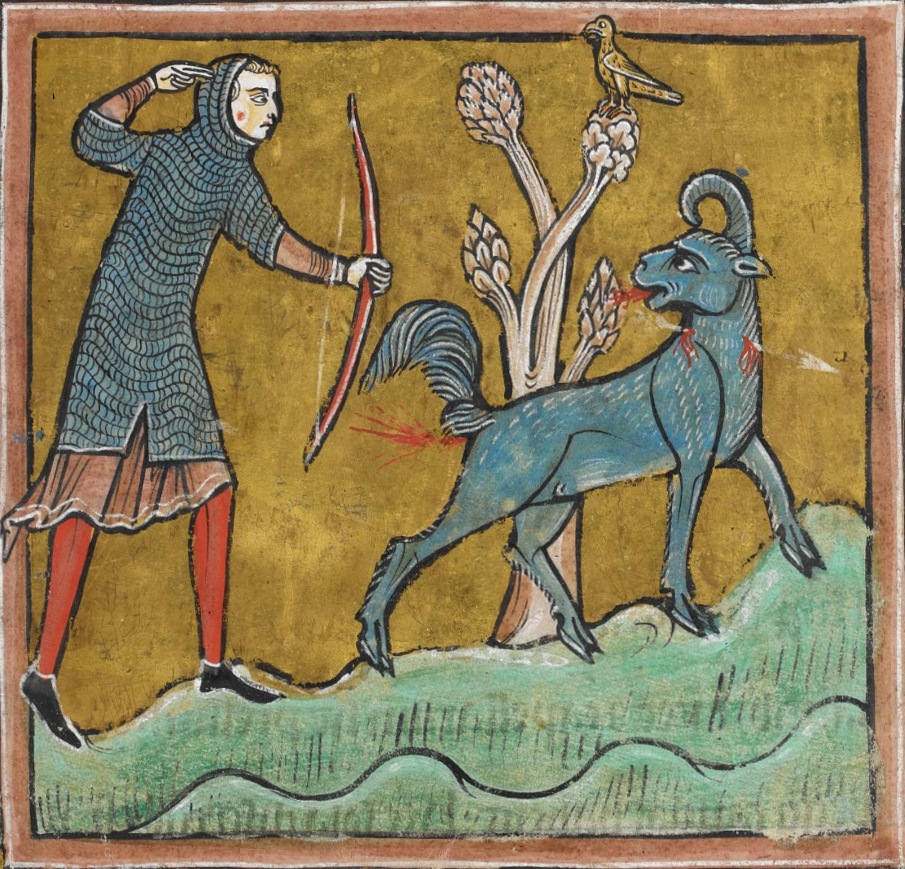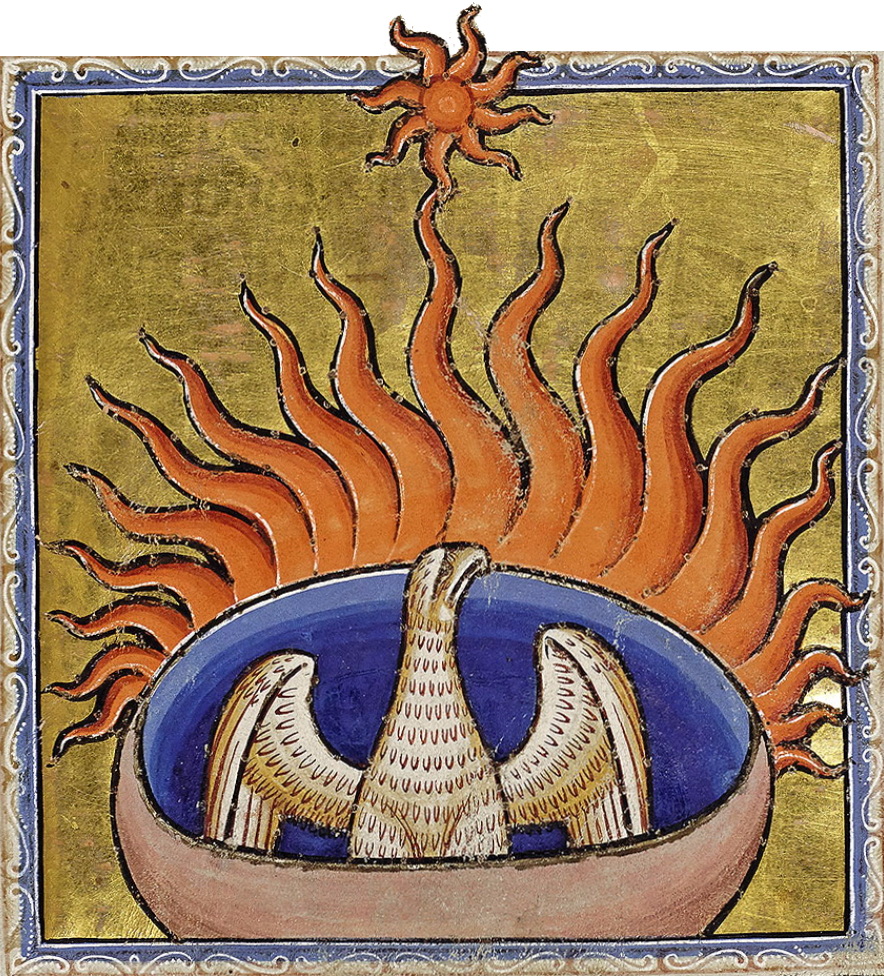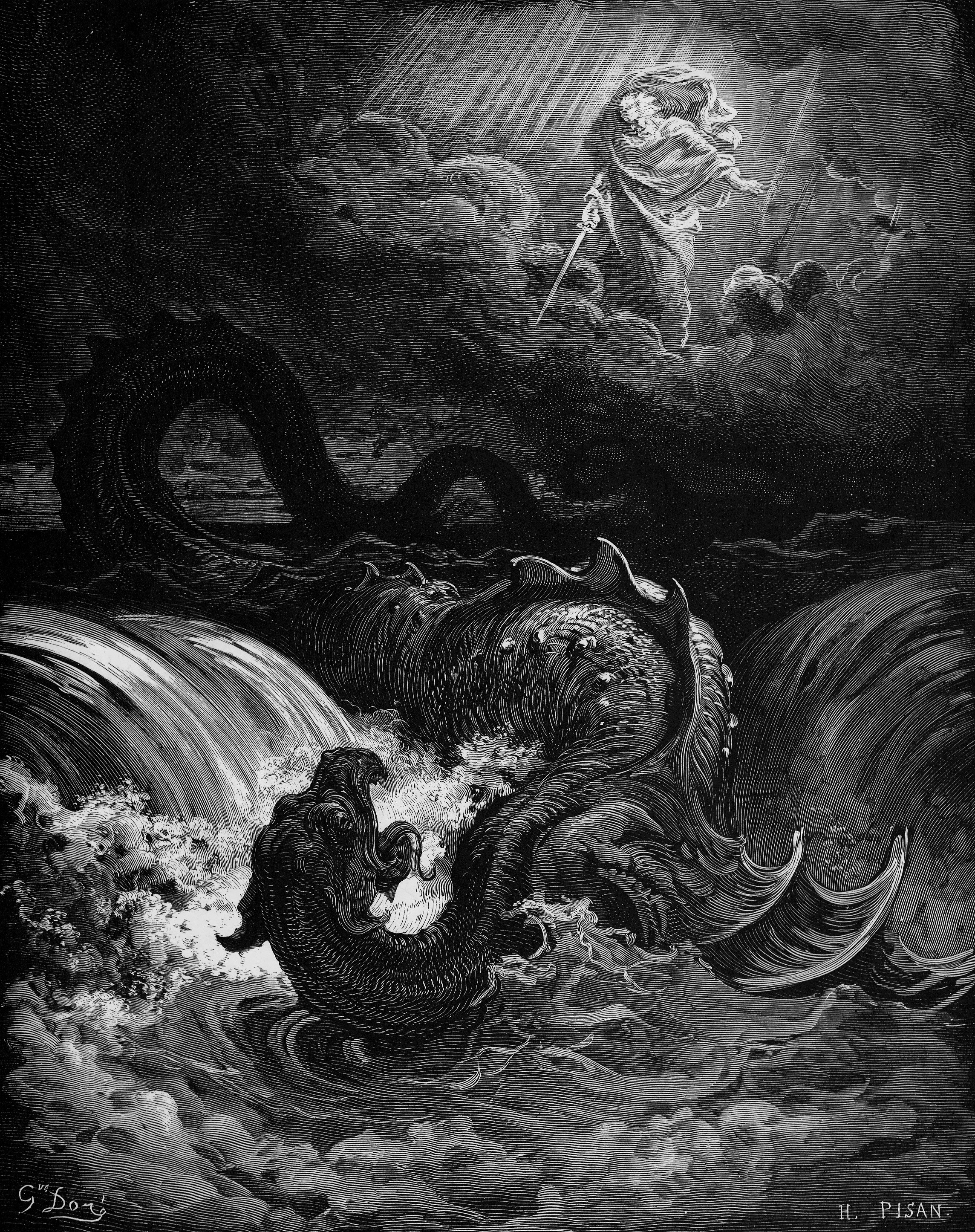|
Bonnacon
The bonnacon (also called bonasus or bonacho) is a legendary creature described as a bull with inward-curving horns and a horse-like mane. Medieval bestiaries usually depict its fur as reddish-brown or black. Because its horns were useless for self-defense, the bonnacon was said to expel large amounts of caustic feces from its anus at its pursuers, burning them and thereby ensuring its escape. Textual history The first known description of the bonnacon comes from Pliny the Elder's ''Naturalis Historia'': The term is derived from Greek βόνᾱσος (''bonasos''), meaning " bison". The popularity of the ''Naturalis Historia'' in the Middle Ages led to the bonnacon's inclusion in medieval bestiaries. In the tradition of the ''Physiologus'', bestiaries often ascribed moral and scriptural lessons to the descriptions of animals, but the bonnacon gained no such symbolic meaning. Manuscript illustrations of the creature may have served as a source of humor, deriving as much from ... [...More Info...] [...Related Items...] OR: [Wikipedia] [Google] [Baidu] |
Aberdeen Bestiary
The ''Aberdeen Bestiary'' (Aberdeen University Library, Univ Lib. MS 24) is a 12th-century English illuminated manuscript bestiary that was first listed in 1542 in the inventory of the Old Royal Library at the Palace of Westminster. Due to similarities, it is often considered to be the "sister" manuscript of the Ashmole Bestiary. The connection between the ancient Greek didactic text ''Physiologus'' and similar bestiary manuscripts is also often noted. Information about the manuscript's origins and patrons are circumstantial, although the manuscript most likely originated from the 13th century and was owned by a wealthy ecclesiastical patron from north or south England. Currently, the Aberdeen Bestiary resides in the Aberdeen University Library in Scotland. History The Aberdeen Bestiary and the Ashmole Bestiary are considered by Xenia Muratova, a professor of art history, to be "the work of different artists belonging to the same artistic milieu." Due to their "striking simila ... [...More Info...] [...Related Items...] OR: [Wikipedia] [Google] [Baidu] |
Tarasque
The Tarasque is a fearsome legendary dragon-like mythological hybrid from Provence, in southern France, tamed in stories about Saint Martha, such as the one told in Jacobus de Voragine's ''Golden Legend'' (13th century). The tarasque was described as having a lion-like head, a body protected by turtle-like carapace(s), six feet with bear-like claws, and a scaly tail like a serpent's tail in a text (pseudo-Marcelle or pseudo-Marcella) which is similar to and roughly coeval with the ''Golden Legend'', and issued poison breath according to one hagiography (pseudo-Raban Maur) of perhaps somewhat later date. Medieval iconography such as renditions in church sculpture did not necessarily conform to this description in the earlier Gothic period, and examples which seemed to were later assigned later, 14th century dates. The hexapedal carapaced tarasque was the form depicted on the city seal of Tarascon around the 15th century, and this held to be the norm in 16th- and 17th-century pai ... [...More Info...] [...Related Items...] OR: [Wikipedia] [Google] [Baidu] |
Bestiary
A bestiary (from ''bestiarum vocabulum'') is a compendium of beasts. Originating in the ancient world, bestiaries were made popular in the Middle Ages in illustrated volumes that described various animals and even rocks. The natural history and illustration of each beast was usually accompanied by a moral lesson. This reflected the belief that the world itself was the Word of God and that every living thing had its own special meaning. For example, the pelican, which was believed to tear open its breast to bring its young to life with its own blood, was a living representation of Jesus. Thus the bestiary is also a reference to the symbolic language of animals in Western Christian art and literature. History The bestiary — the medieval book of beasts — was among the most popular illuminated texts in northern Europe during the Middle Ages (about 500–1500). Medieval Christians understood every element of the world as a manifestation of God, and bestiaries largely focused ... [...More Info...] [...Related Items...] OR: [Wikipedia] [Google] [Baidu] |
Legendary Mammals
Legendary may refer to: * Legend, a folklore genre * Legendary (hagiography) ** Anjou Legendarium * J. R. R. Tolkien's legendarium Film and television * ''Legendary'' (film), a 2010 American sports drama film * ''Legendary'', a 2013 film featuring Dolph Lundgren * ''Legendary'' (TV series), a 2020 American reality competition series * "Legendary" (''Legends of Tomorrow''), a television episode Music Albums * ''Legendary'' (AZ album), 2009 * ''Legendary'' (The Summer Set album) or the title song, 2013 * ''Legendary'' (TQ album) or the title song, 2013 * ''Legendary'' (Tyga album) or the title song, 2019 * ''Legendary'' (Z-Ro album), 2016 * ''Legendary'' (Zao album), 2003 * ''Legendary'', by Kaysha, 2006 * ''The Legendary'', an EP by the Roots, 1999 Songs * "Legendary" (Deadmau5 and Shotty Horroh song), 2017 * "Legendary" (Welshly Arms song), 2016 * "Legendary", by Alaska Thunderfuck from ''Anus'', 2015 * "Legendary", by Daya from '' Daya'', 2015 * "Legendary", by R ... [...More Info...] [...Related Items...] OR: [Wikipedia] [Google] [Baidu] |
Galatia
Galatia (; grc, Γαλατία, ''Galatía'', "Gaul") was an ancient area in the highlands of central Anatolia, roughly corresponding to the provinces of Ankara and Eskişehir, in modern Turkey. Galatia was named after the Gauls from Thrace (cf. Tylis), who settled here and became a small transient foreign tribe in the 3rd century BC, following the Gallic invasion of the Balkans in 279 BC. It has been called the "Gallia" of the East. Geography Galatia was bounded on the north by Bithynia and Paphlagonia, on the east by Pontus and Cappadocia, on the south by Cilicia and Lycaonia, and on the west by Phrygia. Its capital was Ancyra (i.e. Ankara, today the capital of modern Turkey). Celtic Galatia The terms "Galatians" came to be used by the Greeks for the three Celtic peoples of Anatolia: the Tectosages, the Trocmii, and the Tolistobogii. By the 1st century BC, the Celts had become so Hellenized that some Greek writers called them ''Hellenogalatai'' (Ἑλληνογαλάτ� ... [...More Info...] [...Related Items...] OR: [Wikipedia] [Google] [Baidu] |
Leviathan
Leviathan (; he, לִוְיָתָן, ) is a sea serpent noted in theology and mythology. It is referenced in several books of the Hebrew Bible, including Psalms, the Book of Job, the Book of Isaiah, the Book of Amos, and, according to some translations, in the Book of Jonah; it is also mentioned in the Book of Enoch. The Leviathan is often an embodiment of chaos and threatening to eat the damned after their life. In the end, it is annihilated. Christian theologians identified Leviathan with the demon of the deadly sin envy. According to Ophite diagrams, the Leviathan encapsulates the space of the material world. The Leviathan of the Book of Job is a reflection of the older Canaanite ''Lotan'', a primeval monster defeated by the god Baal Hadad. Parallels to the role of Mesopotamian Tiamat defeated by Marduk have long been drawn in comparative mythology, as have been wider comparisons to dragon and world serpent narratives such as Indra slaying Vrtra or Thor slaying Jörm ... [...More Info...] [...Related Items...] OR: [Wikipedia] [Google] [Baidu] |
Dragon
A dragon is a reptilian legendary creature that appears in the folklore of many cultures worldwide. Beliefs about dragons vary considerably through regions, but dragons in western cultures since the High Middle Ages have often been depicted as winged, horned, and capable of breathing fire. Dragons in eastern cultures are usually depicted as wingless, four-legged, serpentine creatures with above-average intelligence. Commonalities between dragons' traits are often a hybridization of feline, reptilian and avian features. Scholars believe huge extinct or migrating crocodiles bear the closest resemblance, especially when encountered in forested or swampy areas, and are most likely the template of modern Oriental dragon imagery. Etymology The word ''dragon'' entered the English language in the early 13th century from Old French ''dragon'', which in turn comes from la, draconem (nominative ) meaning "huge serpent, dragon", from Ancient Greek , (genitive , ) "serpent, giant s ... [...More Info...] [...Related Items...] OR: [Wikipedia] [Google] [Baidu] |
Jacobus De Voragine
Jacobus de Voragine (c. 123013/16 July 1298) was an Italian chronicler and archbishop of Genoa. He was the author, or more accurately the compiler, of the ''Golden Legend'', a collection of the legendary lives of the greater saints of the medieval church that was one of the most popular religious works of the Middle Ages. Biography Jacobus was born either in Varazze or in Genoa, where a family originally from Varazze and bearing that name is attested at the time. He entered the Dominican order in 1244, and became the prior at Como, Bologna and Asti in succession. Besides preaching with success in many parts of Italy, he also taught in the schools of his own fraternity. He was provincial of Lombardy from 1267 till 1286, when he was removed at the meeting of the order in Paris. He also represented his own province at the councils of Lucca (1288) and Ferrara (1290). On the last occasion he was one of the four delegates charged with signifying Pope Nicholas IV's desire for the de ... [...More Info...] [...Related Items...] OR: [Wikipedia] [Google] [Baidu] |
Hagiography
A hagiography (; ) is a biography of a saint or an ecclesiastical leader, as well as, by extension, an adulatory and idealized biography of a founder, saint, monk, nun or icon in any of the world's religions. Early Christian hagiographies might consist of a biography or ', a description of the saint's deeds or miracles (from Latin ''vita'', life, which begins the title of most medieval biographies), an account of the saint's martyrdom (called a ), or be a combination of these. Christian hagiographies focus on the lives, and notably the miracles, ascribed to men and women canonized by the Roman Catholic church, the Eastern Orthodox Church, the Oriental Orthodox churches, and the Church of the East. Other religious traditions such as Buddhism, Hinduism, Taoism, Islam, Sikhism and Jainism also create and maintain hagiographical texts (such as the Sikh Janamsakhis) concerning saints, gurus and other individuals believed to be imbued with sacred power. Hagiographic works, especi ... [...More Info...] [...Related Items...] OR: [Wikipedia] [Google] [Baidu] |
Golden Legend
The ''Golden Legend'' (Latin: ''Legenda aurea'' or ''Legenda sanctorum'') is a collection of hagiographies by Jacobus de Voragine that was widely read in late medieval Europe. More than a thousand manuscripts of the text have survived.Hilary Maddocks, "Pictures for aristocrats: the manuscripts of the ''Légende dorée''", in Margaret M. Manion, Bernard James Muir, eds. ''Medieval texts and images: studies of manuscripts from the Middle Ages'' 1991:2; a study of the systemization of the Latin manuscripts of the ''Legenda aurea'' is B. Fleith, "Le classement des quelque 1000 manuscrits de la Legenda aurea latine en vue de l'éstablissement d'une histoire de la tradition" in Brenda Dunn-Lardeau, ed. ''Legenda Aurea: sept siècles de diffusion", 1986:19-24 It was likely compiled around the years 1259–1266, although the text was added to over the centuries. Initially entitled ''Legenda sanctorum'' (''Readings of the Saints''), it gained its popularity under the title by which ... [...More Info...] [...Related Items...] OR: [Wikipedia] [Google] [Baidu] |
Martha
Martha (Hebrew: מָרְתָא) is a biblical figure described in the Gospels of Luke and John. Together with her siblings Lazarus and Mary of Bethany, she is described as living in the village of Bethany near Jerusalem. She was witness to Jesus resurrecting her brother, Lazarus. Etymology of the name The name ''Martha'' is a Latin transliteration of the Koine Greek Μάρθα, itself a translation of the Aramaic מָרְתָא ''Mârtâ,'' "the mistress" or "the lady", from מרה "mistress," feminine of מר "master." The Aramaic form occurs in a Nabatean inscription found at Puteoli, and now in the Naples Museum; it is dated AD 5 (Corpus Inscr. Semit., 158); also in a Palmyrene inscription, where the Greek translation has the form ''Marthein.'' Pope, Hugh"St. Martha" The Catholic Encyclopedia. Vol. 9. New York: Robert Appleton Company, 1919. Biblical references In the Gospel of Luke, Jesus visits the home of two sisters named Mary and Martha. The two sisters ar ... [...More Info...] [...Related Items...] OR: [Wikipedia] [Google] [Baidu] |
Asia Minor
Anatolia, tr, Anadolu Yarımadası), and the Anatolian plateau, also known as Asia Minor, is a large peninsula in Western Asia and the westernmost protrusion of the Asian continent. It constitutes the major part of modern-day Turkey. The region is bounded by the Turkish Straits to the northwest, the Black Sea to the north, the Armenian Highlands to the east, the Mediterranean Sea to the south, and the Aegean Sea to the west. The Sea of Marmara forms a connection between the Black and Aegean seas through the Bosporus and Dardanelles straits and separates Anatolia from Thrace on the Balkan peninsula of Southeast Europe. The eastern border of Anatolia has been held to be a line between the Gulf of Alexandretta and the Black Sea, bounded by the Armenian Highlands to the east and Mesopotamia to the southeast. By this definition Anatolia comprises approximately the western two-thirds of the Asian part of Turkey. Today, Anatolia is sometimes considered to be synonymous with Asia ... [...More Info...] [...Related Items...] OR: [Wikipedia] [Google] [Baidu] |










